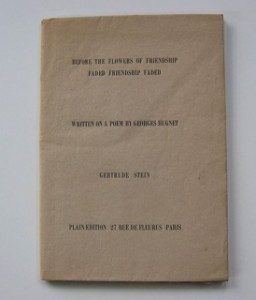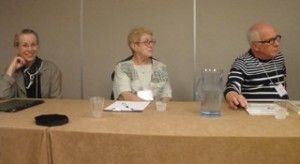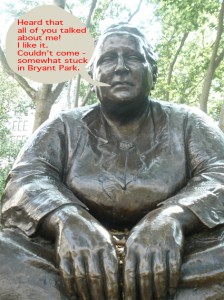There or not there? Gertrude Stein Day at the American Literature Association Conference
“It’s the critics who thought about form, I thought about writing.” (Gertrude Stein)
Imagine my surprise, when I asked my academic audience at the lecture panel whether they were aware of the Stein controversy, Stein the “urban legend,” the Metropolitan Museum crisis and the White House scandal. They had not heard of it. Any of it.
Academia sometimes seems like a far-away, foreign land. Where else would the speakers invited to an intellectual conference have to pay a fee in order to share their papers? I can’t come up with another example. The 400 panels in a long weekend were offered once again at the Hyatt in San Francisco by academics most of whom also had to pay for their air tickets and hotel rooms.
But anywhere, there we were, a morning panel of outliers, bringing news of the year-long raging controversy regarding Stein to Academe.
This was only the third year of Stein’s “official” existence as the object of an scholarly Society. My blog post in 2010 reported the birth of the Gertrude Stein Society and the panel I shared with Gisela Züchner-Mogall, the German-Australian artist who since then has made several appearances on my blog, the most recent one sharing one of her Stein brooches or “tender buttons” with me. Gisela was present once again, this time in the audience, and she had brought more “tender buttons” for the panelists –before heading to New York to see the last days of The Steins Collect and get Gertie’s very personal view of her ALA day.
The morning panel this year was called “Gertrude Stein On View” and all the speakers happened to be friends, all of us local. Denny Stein, a real-live member of Stein’s family, was talking about the 30-year correspondence between her own grandmother, who was a cousin of Stein’s, and Gertrude who was fondly attached to her. Thirty years of yet unpublished letters. Denny Stein presented a Powerpoint with postcards from the edge, written during the Occupation of France, and interpreted Stein’s ways of slyly getting past the censors by writing her best Steinese, saying all was well not so well but all well.
Hans Gallas, probably the world’s most eminent collector of Stein’s first editions and memorabilia of Gertrude and Alice, shared some of his book treasures on the screen and on the desk, woven into amusing anecdotes about how Stein’s books got published. If you have never set eyes on one of the books Stein and Toklas published in the thirties in their own publishing venture, Plain Edition, you would not necessarily grasp the double and triple meanings of the word “plain.”

Hans has also made many appearances on my blog, with cross references to his gertrudeandalice blog and news about his first book, “Gertrude and Alice and Fritz and Tom,” illustrated by another friend, Tom Hachtman.
Newer books on Stein, like his or my photobiography were missing from the scanty book stalls; the once overcrowded book room at the ALA was only half there there. What could it mean? The general book crisis has reached the ivory tower of the ALA?
On the afternoon panel “Gertrude Stein In Places,” we heard about possible influences of Jazz on Stein’s language (by Andrew Vogel), about Stein’s contributions to “Children’s Literature and the Avant-Garde” (by Katie E. Strode), and challenging notes and musings about Stein’s style and rhetoric: “There are different ways of making of, of course,” presented by Sharon Kirsch from Arizona State University.
Kirsch talked about the books on the style of writing that were fashionable when Stein came of age, holding up the ancient canon of rhetoric centered on “exactness” – on “seeing what you describe.” Kirsch showed how Stein followed and bent those classic rules, for example in the Portrait of Picasso where Stein riffs on the “exactness of resemblance”:
“Exact resemblance to exact resemblance, the exact resemblance as exact as a resemblance. Exactly as resembling exactly resembling exactly in resemblance exactly a resemblance exactly and resemblance. For this is so. Because.”
And later, in 1935, Stein sums it up, “It’s the critics who thought about form, I thought about writing.”
Between and after panels, gourmet Hans Gallas took the panelists on long promenades through San Francisco, to be rewarded by superb meals at BlueStem and Il Fornaio restaurants where everyone agreed that Gertie got it right: “Books and food, food and books, both excellent things.”






Well summed, Renate. Thanks for the lovely photo of the 3 of us. Kep up the good fight.
Denny